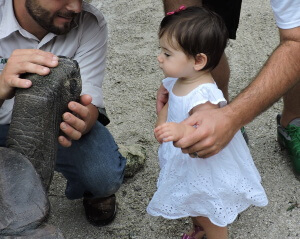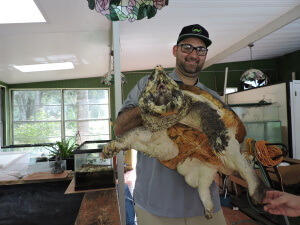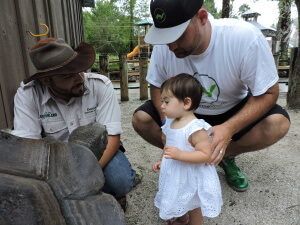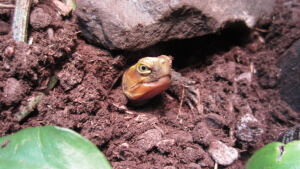Anthony opines on the merits of “hands-off” turtle husbandry
 My night starts like any other, with me laying in bed with my wife and daughter, sitting relatively quietly while my wife and I wait for our little ball of energy to finally tire-out and go to sleep. I usually use this time as an opportunity, much to my wife’s chagrin, to open up my macbook and get some work done. My work, is not work at all, of course. This time of day is when I can unwind from the long day at work and cross some important things of my never-ending “to do” list. I visit all the turtle discussion forums, check out all the turtle Facebook groups, check all of my turtle emails, etc.
My night starts like any other, with me laying in bed with my wife and daughter, sitting relatively quietly while my wife and I wait for our little ball of energy to finally tire-out and go to sleep. I usually use this time as an opportunity, much to my wife’s chagrin, to open up my macbook and get some work done. My work, is not work at all, of course. This time of day is when I can unwind from the long day at work and cross some important things of my never-ending “to do” list. I visit all the turtle discussion forums, check out all the turtle Facebook groups, check all of my turtle emails, etc.
I always get excited when I see one of my friends, especially one of theTurtleRoom staff or one of our close partners or colleagues posting in a discussion forum. I like to see what they have to say in those open arenas, since we often talk on a more personal level much of the time, usually via email, text or phone, often about specific projects on which we are collaborating. I almost always reply in these threads on the forums, just to give a quick shout out to our guys, since I know how hard they work and usually got to see their projects before everyone else became privy to them during the thread in question.
 If anyone knows Chris Leone, our Director of Animal Husbandry, you know what I am talking about. Countless new turtle and tortoise keepers have benefited from his knowledge and the entire herpetoculture movement owes him a debt of gratitude for his work in educating others. This is not an attempt to plug my friend, our websites, or his, as much as it is my effort to express how important it is to listen, or read, when he shares his opinions and experiences in such forums.
If anyone knows Chris Leone, our Director of Animal Husbandry, you know what I am talking about. Countless new turtle and tortoise keepers have benefited from his knowledge and the entire herpetoculture movement owes him a debt of gratitude for his work in educating others. This is not an attempt to plug my friend, our websites, or his, as much as it is my effort to express how important it is to listen, or read, when he shares his opinions and experiences in such forums.
However, one recent evening was particularly interesting. I saw Chris’ name in a thread on TortoiseForum and decided to check it out. In the thread, a well-meaning new keeper was willing to do every and anything possible to ensure that his new companion had the best care possible. An admirable and necessary attribute for any new keeper. Chris had interesting words of wisdom for the group, when he reminded everyone “Provide the necessities, which are really quite simple and then back away. Tortoises really require our absence most of the time after those needs are met.”
To me, this was important. I wondered if everyone who stopped by to read the thread really stopped to think about what this means. It is undoubtedly a fact that the majority of chelonian keepers are new to this game. They keep an animal or two, or ten, and they consider their animals to be pets. Not all too far away from the “herpers” who might keep their Bearded Dragon on a leash or knit sweaters or hats for their Russian Tortoise. There is nothing wrong with these things, but they do contradict what our good friend Chris was saying.
 Over the years, I have seen many online discussions where keepers debated this topic back and forth. Some keepers take pride in the fact that their animals do not get names, while others set up holiday photo shoots with their animals posing in miniature sleighs as stand-ins for Santa Claus. I will say, quickly, while on the topic, that naming animals can have positive outcomes as far as conservation is concerned. If you believe that animals in zoos are ambassadors for their species, planting seeds in budding naturalists, then you can see how giving an animal a memorable name can help a child add the experience to their bank of core memories. Sometimes for keepers, animals just earn names because of their behavior.
Over the years, I have seen many online discussions where keepers debated this topic back and forth. Some keepers take pride in the fact that their animals do not get names, while others set up holiday photo shoots with their animals posing in miniature sleighs as stand-ins for Santa Claus. I will say, quickly, while on the topic, that naming animals can have positive outcomes as far as conservation is concerned. If you believe that animals in zoos are ambassadors for their species, planting seeds in budding naturalists, then you can see how giving an animal a memorable name can help a child add the experience to their bank of core memories. Sometimes for keepers, animals just earn names because of their behavior.
I should try to keep on topic. During public, open, online discussions, like the ones I mention in the previous paragraph, I often share my opinion, in an ever respectful and inviting manner. Usually this approach gets me by with little or no pushback. I am a social worker and consequently take pride in my ability to see both sides, so there is seldom any need to really debate. I guess I am like Switzerland. This topic, however, always brings about debate, even for a softy like me.
My outlook is much like the one Chris shared on the forum that evening. We should strive to keep turtles and tortoises as naturally as possible. This means limited handling, and limited nonsense in general. That is a harsh way of saying that the knitted tortoise sweaters and photos in Santa’s sleigh might be pushing it a bit. In my opinion, a turtle that wants to run from you, defecate on you, or bite you, when handled is probably a very healthy animal. Remember these are just my opinions.
 Part of the issue might be that people like Chris and I have become obsessed with the conservation side of things. Stick around chelonians long enough and it becomes entirely impossible not to become enthralled in this epic battle between man, turtles and extinction. We look at the turtle world through that lens. Every personal phone call we make to a turtle buddy is about this topic and how we can try to creatively do our part to help the situation in some small way. Our lives are almost entirely built around a “starfish on the beach” mentality where we have no choice but to just keep giving all we have to better this seemingly irreversible situation. What other choice do we have?
Part of the issue might be that people like Chris and I have become obsessed with the conservation side of things. Stick around chelonians long enough and it becomes entirely impossible not to become enthralled in this epic battle between man, turtles and extinction. We look at the turtle world through that lens. Every personal phone call we make to a turtle buddy is about this topic and how we can try to creatively do our part to help the situation in some small way. Our lives are almost entirely built around a “starfish on the beach” mentality where we have no choice but to just keep giving all we have to better this seemingly irreversible situation. What other choice do we have?
One might then ask where this leaves our friends keeping turtles as pets. This is where we all surely started, keeping animals simply due to an internal longing to do so and some level of entertainment and companionship. This does not make them wrong. They too will reach a point where they might want to do something about the world and its bleak future for the turtles in it. Perhaps the person keeping Japanese Pond Turtles or Radiated Tortoises owes more to their animals than the person with Russian Tortoises. But what about the person who has unknowingly purchased wild caught Russian Tortoises from a popular national pet store chain, now contributing to the global pet trade crisis? The negative effects of such practice can only be predicted in most cases, even with a “common” species, like this. Maybe this person owes it to their “pet” to research more and provide as naturalistic an environment as possible.
My last point continues that thought. The vast majority of us would agree that providing a naturalistic enclosure for a captive turtle is best practice and should be a goal for all keepers. Anyone who has done so, particularly when keeping animals outdoors, knows that an animal is more likely to react more like a wild animal than an animal kept indoors. There are exceptions to this, of course, but statistically and with most species, most of us would agree this is true. These are the turtles that are more likely to swim away frantically when we approach or try to bite us when we handle them. These are the tortoises that will quickly retreat into their shells when we come around the corner, or pee on us when we grab them. In my experience, this sort of difference between indoor and outdoor behavior might not be as true in tortoises, but you get my gist.
 Lastly, we must decide why we keep these animals. We must also consider what species we keep and what obligations we have based on that fact. The majority of chelonian species are threatened with extinction on some level. We owe them a lot because of that. Additionally, many of the common species, like African Spurred and Russian Tortoises, or Red-Eared Sliders are kept in unsuitable conditions. Between the common and rare species, I am starting to see a trend where we as keepers are not doing enough to justify our efforts in the first place.
Lastly, we must decide why we keep these animals. We must also consider what species we keep and what obligations we have based on that fact. The majority of chelonian species are threatened with extinction on some level. We owe them a lot because of that. Additionally, many of the common species, like African Spurred and Russian Tortoises, or Red-Eared Sliders are kept in unsuitable conditions. Between the common and rare species, I am starting to see a trend where we as keepers are not doing enough to justify our efforts in the first place.
It is my opinion that we owe it to both rare and common turtle and tortoise species to study their individual requirements by reading everything written on their natural history and not just asking someone on Facebook how they keep theirs. There is no excuse not to. Furthermore, until you do familiarize yourself with any and all info on your animal’s native habitat, you have less of an argument as to why your tortoise needs a name or needs to be handled regularly. Do it for your pet, if that’s what you decide to call it.


